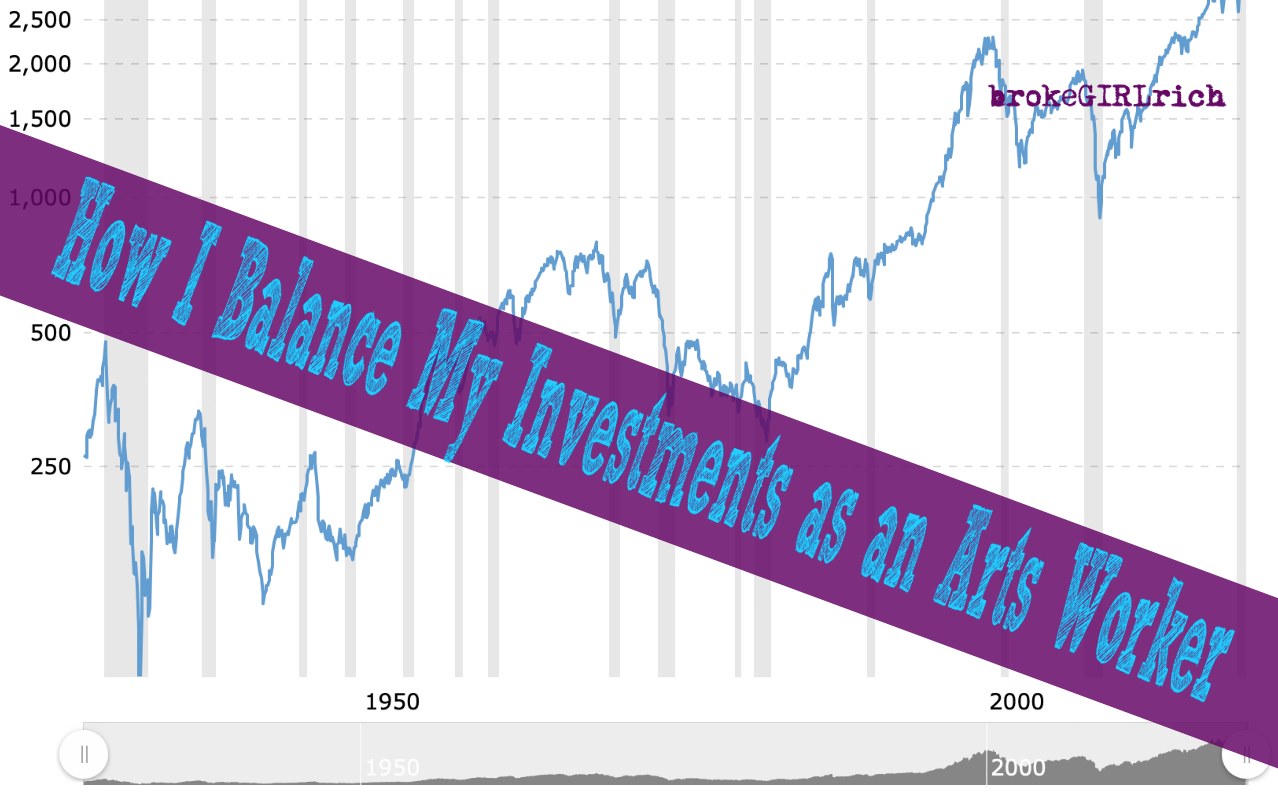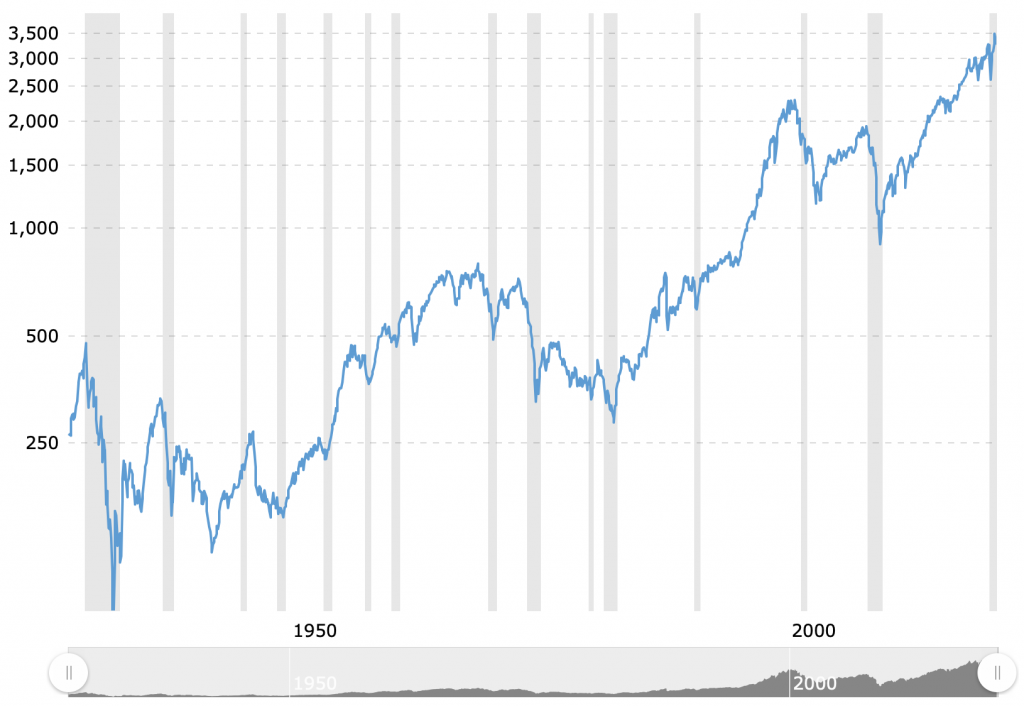
How I Balance My Investments as an Arts Worker | brokeGIRLrich
I was recently asked how I figure out my investments as someone who works in an industry where (at the best of times and certainly in non-pandemic times) we never really know what’s going to happen, and with that in mind, should we only invest with safety in mind?
Investing is such a tricky thing to tackle because it’s so personal and I think it boils down to figuring out some numbers for your long term goals and balancing the level of risk you’re willing to take to get there.
If you’re totally unwilling to take any risk, you’ll probably be limited to things like savings accounts and CDs, which have very low interest rates and are unlikely to keep up with inflation. So you will need to be raking in some dough to meet your goals with those low levels of interest rates.
If you are, awesome.
I’m not. So I felt like I had to take some different approaches.
The very first investing thing I did was to open a Roth IRA and set up a target date fund.
My target date fund allowed me to select the year I thought I would want access to the funds. I picked Fidelity Freedom 2050, so it’s set up for me to “retire” at 66. Now, I can access these funds anytime after I’m 59 ½, but the fund runs itself, with no effort by me, with the idea that I’m retiring in 2050.
It rebalances the assets on its own and will start to switch to less volatile investments as I get closer to 2050. Another nice thing about this fund is that it asked me how aggressive I wanted to be with it when I first set it up.
If you’re extremely risk averse, you can set it to low risk and a target date fund will minimize risks for you and rebalance that way all along.
Personally, I considered a few factors. I was in my mid-twenties when I opened it, which meant that I had a long time before I planned to use it.
While the stock market can be quite the roller coaster from day to day, I had read very helpful articles like this and saw a few useful charts about the average returns from the stock market. Over time, it averages about 10% a year.

Average stock market returns since 1920.
That long time frame gave me plenty of time to change my investment plan if it seemed to fail or select a different fund.
I also knew that in a worst case scenario of losing all my money, I have a massive family and someone would take me in. This is a little thing we gloss over a lot in the personal finance world, but even though that seems like a terrible situation to me, it’s not even an option some people have and those people are naturally even less inclined to take risks.
All this considered, I picked the extremely aggressive option. Essentially, this just means that the fund balances way more heavily with stocks than bonds or cash. Currently, 11 years in and with no effort on my part other than putting money in the account, it’s balanced with 7% in bonds and cash and 93% in various stocks – so it’s still extremely aggressive, which makes sense because it still thinks I’m 30 years out from retiring.
And despite having this set on extremely aggressive, I consider my Roth IRA setup one of the safest and least risky investments.
With my other investments, I actually split them between what I consider very conservative and more risky.
I try to set an investing goal at the beginning of each year for investments other than my retirement fund.
I put 50% of that goal money into broad index funds. These funds invest in essentially the entire stock market or a large number of companies in the stock market.
Specifically, I invest in DIA and ITOT very heavily.
DIA is the Dow Jones Industrial Average ETF and it corresponds to whatever is happening with the Dow Jones Industrial Average. Dow Jones was the man who started The Wall Street Journal in the late 1800s and was known for making complex financial matters easy to understand. He also developed a way of grouping together certain key stocks that reflected the overall health of the U.S. economy. This grouping of stocks became the Dow Jones Industrial Average.
ITOT is the Total U.S. Stock Market ETF, which is just like what the name sounds like.
Since I’m hoping that history will continue to repeat itself and over a long enough period of time, the average annual returns will remain 10%, I consider those my pretty safe investments.
The other 50% I invest, I put into individual companies, which I consider a lot riskier. If one company goes under when I’m invested in every company in the stock market, it doesn’t matter.
When I’m invested in Royal Caribbean Cruise Line and a pandemic shuts down all cruise lines, that stock takes a deep dive.
To pick individual stocks, I narrow it down to things I understand. I subscribe to Kiplingers magazine, so I will say a lot of what I’ve invested in has come from their suggestions once I see it repeated in multiple issues and it’s a company that makes sense to me (this is how I picked Dollar Tree and a real estate REIT).
I also consider some “blue chip” stocks. These are long running companies with excellent reputations (this is how I picked Coca-Cola and Amazon).
And once in a while, if I’ve managed to hit my initial investment goals, I will put some money in a stock that I consider a gamble. I think it has potential but it may not pan out. The current one that I funnel some of that money into is CGC, Canopy Growth Corp., come on full legalization of marijuana.
My “safe” stocks just steadily chug along and grow as expected. The “risky” individual stocks are definitely a lot more volatile, but have some of the bigger payoffs so far.
I think with the riskiness of my career, I try to balance my investments by building a firm foundation of minimal risk options and then once those goals are achieved adding increasingly riskier options with higher possible rewards as I go.



